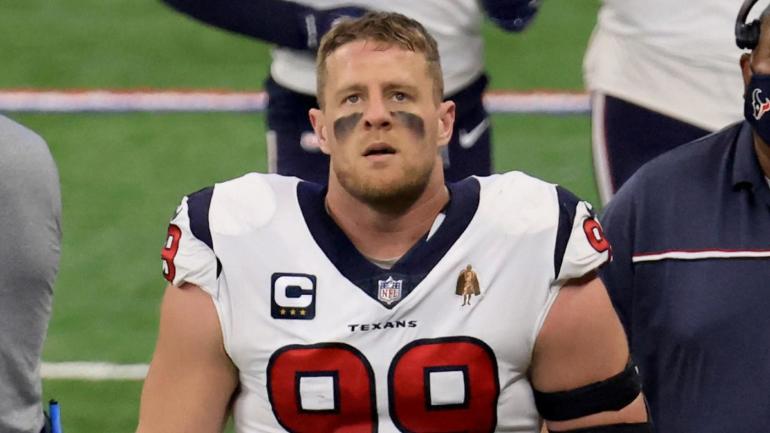
There is a mystery being talked about in NFL circles right now. I've been asked the question myself by some personnel execs. I do not have the answer.
It goes a little something like this: Who the hell were the Cardinals bidding against for J.J. Watt? Who else was paying him $14M a year?
Good question, indeed.
Good for Watt. He did better on the open market than most suspected, but the idea that there were multiple teams throwing offers at him in excess of $15M was simply silly. That market never existed, nor should it have, given the age and injury history of the future first ballot Hall of Famer. That just was not reality. Agent speak on steroids.
There were interested teams, for sure, but few felt the need to throw the kind of money around the Cardinals did, raising plenty of eyebrows in other front offices. Some teams I spoke to were thinking more like $10M a year. Others said they would consider $12M plus incentives. This is a player who has missed a lot of time with a slew of significant injuries, after all, and playing in the trenches is not as conducive to a late-stage renaissance as, say, operating in a clean pocket with a slew or rules in place to protect your position.
Craving even more NFL coverage focusing on previews, recaps, news and analysis? Listen below and subscribe to the Pick Six podcast for a daily dose of everything you need to follow pro football.
Watt earned the right to go wherever he pleases, and hitting the market in a pandemic with the salary cap still in debate and with a mass bloodletting of other talent about to take place was not quite ideal. Not at this stage of his career. Still, the Texans did him more than a solid in letting him go so early – well before the start of the league year in mid-March – and still it was clear that there was not a feeding frenzy. The very best teams had other mouths to feed and cap situations to navigate, and Watt wasn't going to get close to the $17.5M he was set to make in Houston anywhere else, not even as the lone impact defensive lineman on the market.
So to land in essence $28M for two years is actually being lauded around the industry. Was anyone else really pushing the Cardinals into that stratosphere?
"We were shocked by the guaranteed money," said one NFL cap guru. "He basically got two real years at way more money than we thought anyone was paying him. The guarantees in the second year? Wow."
Another NFL exec said: "Good for J.J. But I'm not sure what Arizona was thinking. If anything, that market was a few weeks from getting softer."
An exec from a team that had at least mild interest in Watt said: "Way out of our league."
Some believe Watt's best value could come by playing primarily inside at this point, and wonder if another 1,000 snap campaign makes the most sense given the two-year commitment. Will he put the Cardinals over the top? Does he have two more elite seasons in him? Should make for intriguing theater, no matter what.
One QB prospect stands out as Steelers target
With the Steelers finalizing their new financial arrangement with Ben Roethlisberger, attention will now turn to what they do, or don't do, at the quarterback position this spring. Mike Tomlin was the primary reason Dwayne Haskins was signed to a future's contract, while there are some in the front office who believe Mason Rudolph could still have a future in the organization beyond 2021.
And there is as sense among some other general managers that the Steelers could very well invest a fairly high draft pick on a passer. The name I hear the most in scouting circles is Florida's Kyle Trask. Seems like a fit to people I talk to and someone whose profile would appeal to general manager Kevin Colbert.
"I've known Kevin a long time and the more I see of this kid the more I see him in a Steelers uniform," one GM told me. "He looks the part."
Trask stands a sturdy 6-5, he wasn't a hotshot recruit and Florida was the only big-time program to really pursue him. He didn't see much of the field until an injury to the starting quarterback created an opportunity in 2019, and Trask seized it. He continued his ascent in 2020 including putting up over 400 yards and throwing three touchdowns in a wild loss to Alabama in the SEC Championship.
It's difficult to peg draft slots this early in the process, and some think Trask has an outside shot to get into the first round. Second round may be a safer bet and I'd anticipate the Steelers do plenty of homework on him.
Cap casualty? Don't believe it
Get ready to hear "cap casualty" ad nauseum the next few weeks with the league year approaching. And, well, I'd advise you to disregard it. Because in the overwhelming majority of cases, it's simply not true.
The cap is always fungible. Just look at the case of Roethlisberger and the Steelers and all of the various cap gymnastics they underwent over more than a decade to lower cap numbers and push the payment due date back another few years. Then it got real when the team no longer thought the player was worth his salary, and he took less to stay. Sure, if not for the huge dead cap figure they very well may have moved on entirely – so cap certainly played a role – but had Big Ben balked at this price-point he'd probably be gone, anyway.
It's about the cap … until it isn't. And the reason so many players will be let go is because their current team does not want to use the fund currently dedicated to that player for 2021. They do not think he is worth the salary and/or bonus payment attached to his name. Otherwise, they'd make it worth his while to convert some salary to a bonus and lower his number and make it a win/win.
And in many cases the reason that player gets cut is because he doesn't want to take less to stay when the topic is broached, and he and his agent believe they can get a better opportunity elsewhere, or they prefer to do a prove-it deal with a team they believe will put them in a better financial opportunity on the market again in 2020, when the cap should start moving up.
The reason it gets to that point is because the front office and owner do not want to pay what the contract says is due. It's better PR to make it about the cap – it sounds better, right? – but half the teams in the NFL spent over the cap last year. It is almost always about the money.
![[object Object] Logo](https://sportshub.cbsistatic.com/i/2020/04/22/e9ceb731-8b3f-4c60-98fe-090ab66a2997/screen-shot-2020-04-22-at-11-04-56-am.png)


















